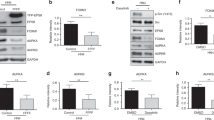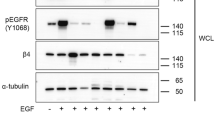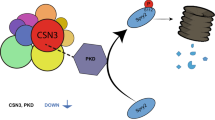Abstract
Two isoforms of Eps8, p97Eps8 and p68Eps8, have been identified as the substrates for receptor tyrosine kinases. Our previous studies indicated that both tyrosyl phosphorylation and protein expression of Eps8 were elevated in v-Src transformed cells. In an attempt to examine the role played by p97Eps8 in tumorigenesis, we have first obtained cells overexpressing p97Eps8 and its pleckstrin homology (PH)-truncated variant. We then demonstrated that cells overexpressing p97Eps8 not only exhibited the ability of focus formation in cell culture but also promoted the tumor formation in mice as compared to controls. Furthermore, elevated serum-induced extracellular responsive kinase (ERK) activation was observed in p97Eps8 overexpressors. This enhanced ERK activation was sensitive to a MEK1 specific inhibitor PD98059 and was important for p97Eps8-mediated transformation, since transfection of vectors expressing dominant negative MEK1 and p97Eps8 abrogated focus formation by p97Eps8. In contrast, PH-truncated p97Eps8 failed to localize at the plasma membrane and that the truncated variant also did not elevate ERK activation and cellular transformation in response to serum stimulation. Our results thus indicated that: (i) the gene encoding p97Eps8 was an oncogene; (ii) p97Eps8-induced oncogenesis was partly mediated by ERK activation; and (iii) the PH domain of p97Eps8 was critical for its cellular localization, ERK activation and its ability to transform cells.
This is a preview of subscription content, access via your institution
Access options
Subscribe to this journal
Receive 50 print issues and online access
$259.00 per year
only $5.18 per issue
Buy this article
- Purchase on Springer Link
- Instant access to full article PDF
Prices may be subject to local taxes which are calculated during checkout





Similar content being viewed by others
References
Biesova Z, Piccoli C and Wong WT. . 1997 Oncogene 14: 233–241.
Castagnino P, Biesowa Z, Won WT, Fazioli F, Gill GN and Di Fiore PP. . 1995 Oncogene 10: 723–729.
Falasca M, Logan S.K, Lehto VP, Baccante G, Lemmon MA and Schlessinger J. . 1998 EMBO J. 17: 414–422.
Fazioli F, Minichiello L, Matoska V, Castagnino P, Miki T, Wong WT and Di Fiore PP. . 1993 EMBO J. 12: 3799–3808.
Ferguson KM, Lemmon MA, Schlessinger J and Sigler PB. . 1995 Cell 83: 1037–1046.
Franke TF, Kaplan DR, Cantley LC and Toker A. . 1997 Science 275: 665–668.
Frech M, Andjelkovic M, Ingley E, Reddy KK, Falck JR and Hemmings BA. . 1997 J. Biol. Chem. 272: 8474–8471.
Gallo R, Provenzano C, Carbone R, Di Fiore PP, Castellani L, Falcone G and Alema S. . 1997 Oncogene 15: 1929–1936.
Harlan JE, Hajduk PJ, Yoon HS and Fesik SW. . 1994 Nature 371: 168–170.
Karlsson T, Songyang Z, Landgren E, Lavergne C, Di Fiore PP, Anafi M, Pawson T, Cantley LC, Claesson-Welsh L and Welsh M. . 1995 Oncogene 10: 1475–1483.
Costa GL, Benson JM, Seroogy CM, Achacoso P, Fathman CG and Nolan GP. . 2000 J. Immunol. 164: 3581–3590.
Kavran JM, Klein DE, Lee A, Falasca M, Isakoff SJ, Skolnik EY and Lemmon MA. . 1998 J. Biol. Chem. 273: 30497–30508.
Kishan KV, Scita G, Wong WT, Di Fiore PP and Newcomer ME. . 1997 Nat. Struct. Biol. 4: 739–743.
Klippel A, Kavanaugh WM, Pot D and Williams LT. . 1997 Mol. Cell. Biol. 17: 338–344.
Maa M-C, Wilson LK, Moeyers JS, Vines RR, Parsons JT and Parsons SJ. . 1992 Oncogene 7: 2429–2438.
Maa M-C, Lai J-R, Lin R-W and Leu T-H. . 1999 Biochim. Biophys. Acta 1450: 341–351.
Matoskova B, Wong WT, Salcini AE, Pelicci PG and Di Fiore PP. . 1995 Mol. Cell. Biol. 15: 3805–3812.
Matoskova B, Wong WT, Nomura N, Robbins KC and Di Fiore PP. . 1996 Oncogene 12: 2679–2688.
Mongiovi AM, Romano PR, Panni S, Mendoza M, Wong WT, Musacchio A, Cesareni G and Di Fiore PP. . 1999 EMBO J. 18: 5300–5309.
Morgenstern JP and Land H. . 1990 Nucl. Acids Res. 18: 3587–3596.
Musacchio A, Gibson T, Rice P, Thompson J and Saraste M. . 1993 TIBS 18: 343–348.
Pawson T and Scott JD. . 1997 Science 278: 2075–2080.
Payne DM, Rossomando AJ, Martino P, Erickson AK, Her JH, Shabanowitz J, Hunt DF, Weber MJ and Sturgill TW. . 1991 EMBO J. 10: 885–892.
Provenzano C, Gallo R, Carbone R, Di Fiore PP, Falcone G, Castellani L and Alema S. . 1998 Exp. Cell Res. 242: 186–200.
Reuter CWM, Catling AD and Weber MJ. . 1995 Meth. Enzymol. 255: 245–256.
Scita G, Nordstrom J, Carbone R, Tenca P, Glardina G, Gutkind S, Bjarnegard M, Betsholtz C and Di Fiore PP. . 1999 Nature 401: 290–293.
Sturgill TW, Ray LB, Erikson E and Maller JL. . 1988 Nature 334: 715–718.
Touhara K, Inglese J, Pitcher JA, Shaw G and Lefkowitz RJ. . 1994 J. Biol. Chem. 269: 10217–10220.
Troppmair J, Bruder JT, Munoz H, Lloyd PA, Kyriakis J, Banerjee P, Avruch J and Rapp UR. . 1994 J. Biol. Chem. 269: 7030–7035.
Tsukuda S, Simon MI, Witte ON and Katz A. . 1994 Proc. Natl. Acad. Sci. USA 91: 11256–11260.
Wong WT, Carlomagno F, Druck T, Barletta C, Croce CM, Huebner K, Kraus MH and Di Fiore PP. . 1994 Oncogene 9: 3057–3061.
Acknowledgements
We thank Dr Sally Parsons and Dr Michael Weber for the pBabe (puro) expression vector and polyclonal ERK antibody (TR2) respectively, Dr Garry P Norlan and Dr Sue Lin-Chao for the virus-packaging cell line ΦNX-Eco and Dr Ching-Hsine Huang and Dr Hsin-Fang Yang-Yen for their critical comments on this manuscript. We appreciate the technical help provided by Ya-Chun Chuang, Hsaio-Hwai Chen and Hong-Ming Lin. We are also grateful to the animal center at NCKU for the care of animals. This work was supported by National Science Council Grant to M-C Maa (NSC 89-2320-B-006-007) and grants of NHRI to T-H Leu (DOH-87-HR-625, NHRI-GT-EX89S932L).
Author information
Authors and Affiliations
Rights and permissions
About this article
Cite this article
Maa, MC., Hsieh, CY. & Leu, TH. Overexpression of p97Eps8 leads to cellular transformation: implication of pleckstrin homology domain in p97Eps8-mediated ERK activation. Oncogene 20, 106–112 (2001). https://doi.org/10.1038/sj.onc.1204069
Received:
Revised:
Accepted:
Published:
Issue Date:
DOI: https://doi.org/10.1038/sj.onc.1204069
Keywords
This article is cited by
-
A synthetic cell-penetrating peptide derived from nuclear localization signal of EPS8 exerts anticancer activity against acute myeloid leukemia
Journal of Experimental & Clinical Cancer Research (2018)
-
SCFFbxw5 mediates transient degradation of actin remodeller Eps8 to allow proper mitotic progression
Nature Cell Biology (2013)
-
The interplay between Eps8 and IRSp53 contributes to Src-mediated transformation
Oncogene (2010)
-
Upregulation of Eps8 in oral squamous cell carcinoma promotes cell migration and invasion through integrin-dependent Rac1 activation
Oncogene (2009)



